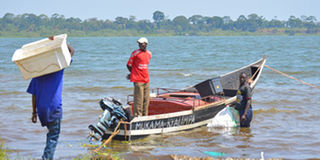Prime
Half of Ugandans at risk of contracting tropical diseases

Bilharzia worms penetrate the skin when a person comes in contact with contaminated water. Once in the body, the parasites cause severe damage. File Photo
What you need to know:
Little attention has been paid to certain parasitic and bacterial tropical diseases but they pose great risk to the public, writes Beatrice Nakibuuka
The neglected tropical diseases (NTDs) are a group of parasitic and bacterial diseases which have been completely wiped out of developed communities but still persist in poor marginalised societies.
According to Dr Tomson Lakwo, a senior entomologist and programme manager at the control division of the ministry of health, these diseases are referred to as neglected because they are slow killers and, therefore, little attention has been paid to them in the past.
However, there is now global momentum towards eliminating them and many countries have come up to eradicate them.
There are about 12 of these diseases in Uganda but the health ministry handles only five because of inadequate funding. They include; river blindness, elephantiasis, bilharzia, intestinal worms and trachoma. The other diseases include; guinea worm, leprosy, plague, kalazaar, cysticercosis caused by tape worms, buruli ulcers and sleeping sickness.
In Uganda, the diseases have been recognised as a public health challenge affecting almost all the 112 districts of the country. Elephantiasis is endemic in 54 districts, river blindness in 36, and bilharzia in 74 while trachoma is endemic 41 districts of Uganda.
High prevalence rates
“Over half of the total population of Uganda is at risk of contracting at least one of these diseases so the district health officers must make their people aware of these diseases,” says Dr Lakwo. If we want to eradicate poverty, we must have a healthy population first.
1. Trachoma is more prevalent in dry places such as Busoga and Karamoja subregions where there is scarcity of water, making it hard for people to wash their eyes regularly. The disease, according to Dr Lakwo mostly affects children and if not treated, can lead to total blindness.
“Washing eyes regularly and seeking early treatment can reverse the diverse effects of trachoma,” he says.
2. Elephantiasis is caused by the same mosquito that spreads malaria. Once the parasite gets into the body, it may take a year or more for the signs of disease to show.
“At the chronic stage, the parasites block the lymphatic system causing severe swelling of the hands and legs. It usually affects people above 15 years and while at the chronic stage, the disease is not treatable,” says Dr Lakwo.
3. Bilharzia worms penetrate the skin after contact with contaminated water. The parasites settle in the liver and the hatched worms deposited in the stomach. A person with the disease gets diarrhoea with bloody stool, vomiting of blood and there is always severe damage to the spleen.
4. River blindness is an eye and skin disease spread by a black fly which commonly breeds in fast-flowing rivers. It increases the risk of blindness if untreated, and is widespread in Kitgum District. The filaria worm from the black fly bite is very toxic to the skin and the eye, producing terrible itching and various eye lesions.
After several bites from this fly, the lesions may lead to irreversible blindness and disfiguring skin diseases sometimes referred to as “leopard” or “lizard” skin.
5. All Ugandans are at risk of getting intestinal worms because it is very difficult to monitor hygiene as there are many people who handle the food we eat. Not washing fruits, vegetables or even hands predisposes us to getting stomach worms. “The worms cause anaemia as they feed on the host’s blood and the person has to share food nutrients with the worms. This has caused many children to become malnourished and have retarded growth,” says Dr Lakwo.
What has been done?
Uganda’s integrated Neglected Tropical Diseases (NTD) programme has completed the nationwide documentation of the burden of each of the targeted NTDs. This data helps Uganda to appropriately target the areas that require treatment.
The national NTD program has successfully expanded treatment campaigns for the five targeted NTDs; reaching over 30,000 communities and 16,000 schools and institutions in more than 80 districts nationwide.
Currently, over half of the population has received NTD treatments.
The master plan provides a road map for Uganda to be free of neglected tropical diseases and related morbidity and disabilities by 2020 and recommits the government and partners to achieving this goal.
Queen Elizabeth Diamond Jubilee Trust, Sight Savers International and the Carter Centre are some of the agencies working in partnership with government to ensure that the neglected diseases, specifically trachoma and onchocerciasis are eradicated.
“Since 1992, The Carter Center embarked on onchocerciasis as a control programme, and later in 2007, as an elimination programme. It has also provided government with financial and technical support in addition to capital equipment,” says Peace Habomugisha the country representative of the Carter Centre Uganda.
The Queen Elizabeth Diamond Jubilee Trust started its campaign last year to support trachoma treatment in Karamoja and Busoga regions and The Carter Centre was mandated by the Trust to coordinate the trachoma programme in these two regions. “There is still hope that Queen Elizabeth Diamond Jubilee Trust will extend similar support to other districts that are trachoma endemic,” says Habomugisha.
The public is encouraged to take advantage of the free medication that is available for distribution especially at health centres in the high risk areas.




